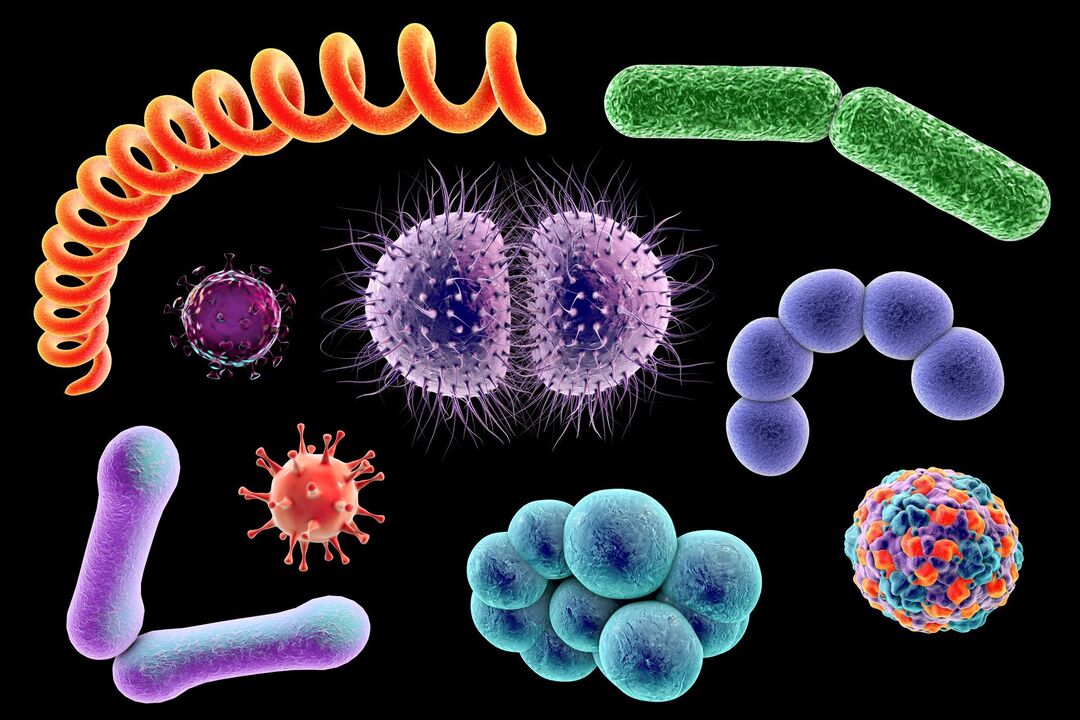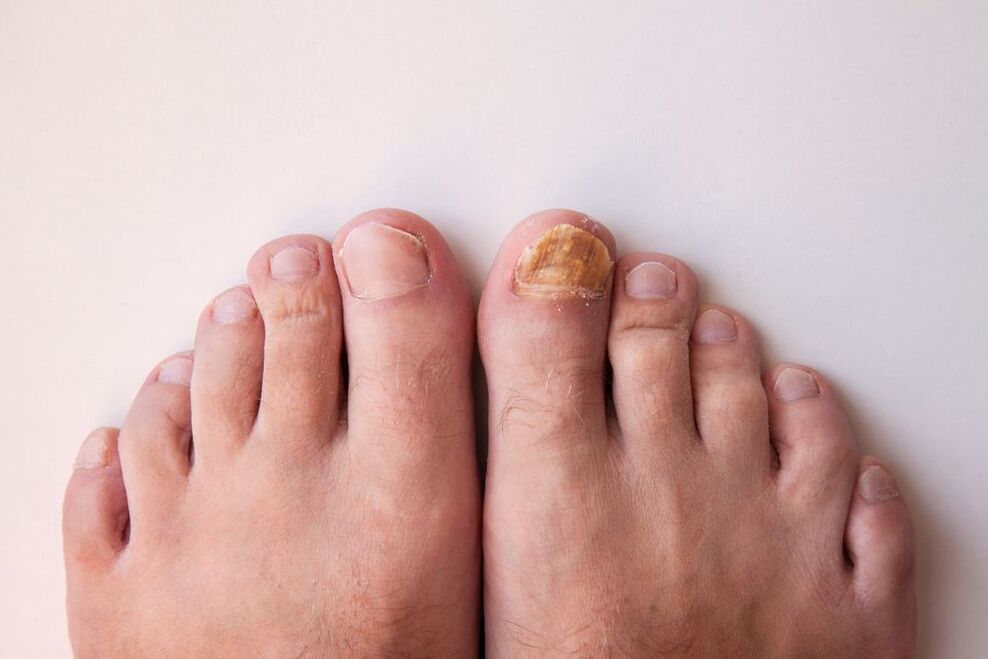Fungus (mycosis) on the feet– Fungal infections of the skin of the feet and interdigital folds, nails, caused by pathogenic and conditionally pathogenic fungi. Conditional pathogens are natural residents that are present in small quantities in the normal microflora of the skin and mucous membranes. However, under certain conditions, fungi begin to acquire pathogenic (disease-causing) properties and cause disease. Regardless of the pathogen, the disease has similar symptoms and treatment tactics.

In 9 out of 10 cases, fungi of the Trichophyton genus are the cause of mycoses on the legs. According to statistics, men develop a fungal infection of the skin of the feet more often than women. Men account for almost 58% of all cases. Nail fungus (onychomycosis) most often develops on the nail plates III-IV of the feet. Long-term untreated nail fungus often becomes the cause of mycosis on the feet and vice versa. It should be noted that some non-fungal skin diseases can be complicated by the occurrence of a fungal disease. Eczema on the feet is often accompanied by mycoses.
Symptoms of athlete's foot

Dermatophytosis of the feet
Dermatophytosis of the feet (tinea pedis - athlete's foot) is the most common mycosis of the foot and cuticles. Fungal process on the feet, usuallybegins with damage to the side surfaces. Scaly peeling (flaking) of the skin may occur. This process is not always accompanied by discomfort, itching or pain.
Over time, hyperkeratosis develops –Thickening of the skin. Sometimes you may notice a slight redness of the skin accompanied byfloury peeling, which gives the skin a "powdered appearance". The skin is dry, itching and pain may occur. If a fungal infection remains untreated at this stage, diaper rash in the interdigital spaces will occur after some time. The interdigital form of athlete's foot is most commonthe folds between the third and fourth, fourth and fifth fingers. Skin defects can form, which are characterized by a violation of its integrity (erosion) and painful cracks. In the interdigital form (intertriginous), pronounced itching symptoms and partial burning of the affected skin areas occuron.
INneglected formFungal disease of the feet occurs with formation on the surfaces of the fingersBlowfilled with clear fluid and covered with a thick stratum corneum. "Sago grains" (blisters) can be single or merge into multi-chambered blisters. When pyococci (purulent bacteria) join, the contents of the blisters become cloudy, then they open and erosions are formed, covered with purulent hemorrhagic crustsInflammation of the lymph nodes and a deterioration in general health are possible.
When blisters appear, it is important not to confuse a fungal infection with dyshidrotic eczema. Only a doctor can understand and accurately diagnose the problem! Mycides (allergic rash) are observed in 2/3 of patients with interdigital and advanced forms of tinea pedis.
Of course, the identification of clinical forms is conditional, since their combination often occurs - one form can transform into another. It all depends on the body's reaction, physical activity and treatment methods of the patient.
The nails are also often affected by mycosis of the feet, especially on the first and fifth toes. The nail plate develops yellowish spots or stripes, the surface becomes dull and uneven and a horny thickening begins to form under the nail, which subsequently leads to the destruction of the nail plate.
Yeast-like mycoses of the feet
Recently, fungal infections of the feet caused by fungi of the genus Candida have become widespread. This is believed to be due to the widespread use of antibiotics and cytostatics (antitumor drugs).
MushroomsGenus Candida, which lodge in the interdigital folds, cause abrasions and diaper rash-like symptoms of the skin. All interdigital spaces are often involved in the skin process. There is pain and burning of the skin between the toes. Nail candidiasis (infection with Candida fungi) occurs more often on the hands of women - housewives, laundresses, dishwashers, food sellers in canteens. The nail plates loosen, flake off and white spots appear.
Mold mycoses of the feet
Mold mycoses occur primarily in countries where people traditionally walk barefoot (India, African countries). This type of mycosis also occurs in regions with a temperate climate, but usually in patients with immunodeficiency and in people who frequently come into contact with soil and plants. The color of the nail plate depends on the type of pathogen in question. The nail plate may even turn black.
However, when painting the nail in this way, it is important not to overlook the malignant form of the tumor on the finger skin -subungual melanoma.For a correct diagnosis, a visit to the doctor is absolutely necessary!Fungal changes on the skin of the feet and nails can often occur at the same time. On the one hand, this can serve as confirmation of a general fungal nature, but on the other hand, it can also mask other skin problems.
A change in the color or thickness of the nail plate is not always necessarily onychomycosis (nail fungus). Nails can be damaged by injury, wearing tight shoes, using poor quality polish, or a bacterial infection. For example, the nail plate turns green due to an infection with Pseudomonas aeruginosa. Nevertheless, colors such as yellow-brown, gray, whitish should indicate a fungus and the need for laboratory diagnostics. In addition, with a fungal infection, the thickness of the nails can remain normal or, on the contrary, become very thin.
Causes of athlete's foot
The main reasons for the development of fungal infections on the feet are:
- Increased sweating of the feet.
- Presence of chronic diseases.Diabetes mellitus, certain blood diseases, long-term use of antibiotics or immunosuppressive (immunosuppressing) drugs contribute to the development of a fungal infection and the spread of the disease to other parts of the body.
- Presence of microtraumas on the legs.Small tears and cuts are a direct route of infection. Therefore, it is very important to immediately treat damaged skin areas with antiseptic agents.
- Non-compliance with hygiene regulations.Walking without shoes in public places (baths, saunas, swimming pools) is fraught with fungal infections.
Cream for the treatment of athlete's foot
Thanks to its special chemical structure, the drug has a triple effect on fungi: it helps to suppress their growth, reproduction and death, and blocks the transition of fungi to a pathogenic form. Sertaconazole also has good lipophilicity (the ability to dissolve in the fatty structures of cells). This ensures rapid and effective penetration of the drug into the skin and enhances the local antifungal effect. At the same time, the development of resistance of the fungal infection to treatment is practically not observed. The drug has an antibacterial effect against streptococci and staphylococci, relieves itching and inflammation.
So, the benefits of creams are:
- Broad spectrum of antifungal effects
- Triple effect on fungal cells
- Reduced itching, inflammation and antibacterial effect
- Good penetration into affected skin areas and long-lasting antifungal effect due to lipophilicity
- Can be used during pregnancy and breastfeeding if the expected benefits to the mother outweigh the possible risks to the unborn child
The drug has an antibacterial effect against streptococci and staphylococci, relieves itching and inflammation
Applying creams
For fungal infections of the feet, it is recommended to apply the product in a thin layer to the affected skin area 1-2 times a day for 2-4 weeks, covering 1 cm of healthy skin. Have a triple effect: antifungal, antipruritic, anti-inflammatory
Prevention of athlete's foot
To prevent fungal infection of the feet and nails, you must follow the following preventive measures:
- Disinfect shoes while treating athlete's foot
- Pay attention to personal hygiene and do not walk barefoot in public places (swimming pools, saunas, baths).
- Don't wear other people's shoes
- Choose shoes according to the season and preferably made from natural materials.
- Treat fresh wounds and cuts immediately
- Use products to reduce foot sweating
Answers to questions
Can you become infected with the fungus again?
Answer:Yes you can. Previous fungal skin diseases do not lead to permanent immunity. Therefore, you can become infected with the fungus an unlimited number of times.
What is better for treating fungus: tablets or creams and ointments?
Answer:The treatment regimen is determined solely by the attending physician. The severity and degree of the fungal infection are taken into account. As a rule, fungal infections of the feet and nail plates are treated with local (external) remedies.

























